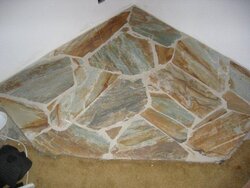Hi everyone,
We're getting our first woodstove and would like to try making the hearth pad. I have some info from the installers, and have been doing some research, but thought I would ask here to see if I could get a better idea of what we need to do. Stove is a Lopi Liberty (on legs, corner installation). It is being installed in a finished basement area, carpeting over cement slab. We have flagstone (well, basically flat rocks that we packed in from the back 40) that we'd like to use.
The installer told me to attach Duroc on top of a sheet of plywood (1/2 or 3/4 inch) and add 2x4s or other lumber to make sides. Then fill with type S mortar and lay stones inside. He said that it does not need to be attached to the floor and the carpet shouldn't need to be removed (pending final approval from the code officer, of course).
My questions:
What is the purpose of the plywood? It seems that it would be safer not to add a combustible material there. Is it needed to secure the sides, or can I screw them right into the Duroc? I don't know the R-value needed offhand (will be asking the installers, or maybe one of you helpful folks knows?) but if I removed the carpet and just had the Duroc, mortar and stone on the concrete slab then there would be no combustibles under the stove at all.
How do I go about laying the stones? I'm assuming that I level the mortar and just set them in as desired, smoothing out the mortar in between stones as needed. Do I need to "shim" under stones that are thinner, or not level on the bottom, or is the wet mortar viscous enough to support them? How much time will I have to manipulate them before the mortar dries?
Thanks,
Sarah
We're getting our first woodstove and would like to try making the hearth pad. I have some info from the installers, and have been doing some research, but thought I would ask here to see if I could get a better idea of what we need to do. Stove is a Lopi Liberty (on legs, corner installation). It is being installed in a finished basement area, carpeting over cement slab. We have flagstone (well, basically flat rocks that we packed in from the back 40) that we'd like to use.
The installer told me to attach Duroc on top of a sheet of plywood (1/2 or 3/4 inch) and add 2x4s or other lumber to make sides. Then fill with type S mortar and lay stones inside. He said that it does not need to be attached to the floor and the carpet shouldn't need to be removed (pending final approval from the code officer, of course).
My questions:
What is the purpose of the plywood? It seems that it would be safer not to add a combustible material there. Is it needed to secure the sides, or can I screw them right into the Duroc? I don't know the R-value needed offhand (will be asking the installers, or maybe one of you helpful folks knows?) but if I removed the carpet and just had the Duroc, mortar and stone on the concrete slab then there would be no combustibles under the stove at all.
How do I go about laying the stones? I'm assuming that I level the mortar and just set them in as desired, smoothing out the mortar in between stones as needed. Do I need to "shim" under stones that are thinner, or not level on the bottom, or is the wet mortar viscous enough to support them? How much time will I have to manipulate them before the mortar dries?
Thanks,
Sarah



